[nextpage title=”Introduction”]
Antec sells decent high-end power supplies, but how about their more affordable models? Today we decided to review a 500 W from their Basiq series (BP500U) that costs only USD 60. Will it survive our tests?
This unit looks like it is manufactured by FSP, but we couldn’t confirm this.
 Figure 1: Antec Basiq BP500U power supply.
Figure 1: Antec Basiq BP500U power supply.
 Figure 2: Antec Basiq BP500U power supply.
Figure 2: Antec Basiq BP500U power supply.
Basiq BP500U is a small power supply (5 ½” or 14 cm deep), remembering “generic” power supplies because of its color and also because of the presence of an 80 mm fan on the rear, just like the very first power supplies. Differently from old and “generic” units Basiq BP500U has active PFC circuit.
Basiq BP500U does not use nylon sleeving on any of its cables, and the included cables are:
- Main motherboard cable with a 20/24-pin connector.
- Cable with two ATX12V connectors that together form one EPS12V connector.
- One cable with two six-pin auxiliary power connectors for video cards.
- One SATA power cable with three SATA power connectors.
- One peripheral power cable with two standard peripheral power plugs and one floppy disk drive power connector.
- One cable with two standard peripheral power plugs and one SATA power plug.
The number of cables is good enough for an entry-level or mainstream PC, but we think that Antec should have used a six/eight-pin connector on one of the video card auxiliary power connectors in order to allow you to install a very high-end video card that requires one eight-pin power connector and one six-pin power connector at the same time. Both video card connectors are available on the same cable, and we prefer when each connector uses its own cable. The reason is that when these connectors are attached to the same cable the voltage on the connectors tends to drop when the power supply is fully loaded.
All cables have 20” (51 cm) between the power supply housing and the first connector on the cable. On the peripheral power cables there is 5 7/8” (15 cm) between connectors. All wires are 18 AWG, which is the correct gauge to be used.
Now let’s take an in-depth look inside this power supply.
[nextpage title=”A Look Inside The Basiq BP500U”]
We decided to disassemble this power supply to see what it looks like inside, how it is designed, and what components are used. Please read our Anatomy of Switching Power Supplies tutorial to understand how a power supply works and to compare this power supply to others.
This page will be an overview, and then in the following pages we will discuss in detail the quality and ratings of the components used.
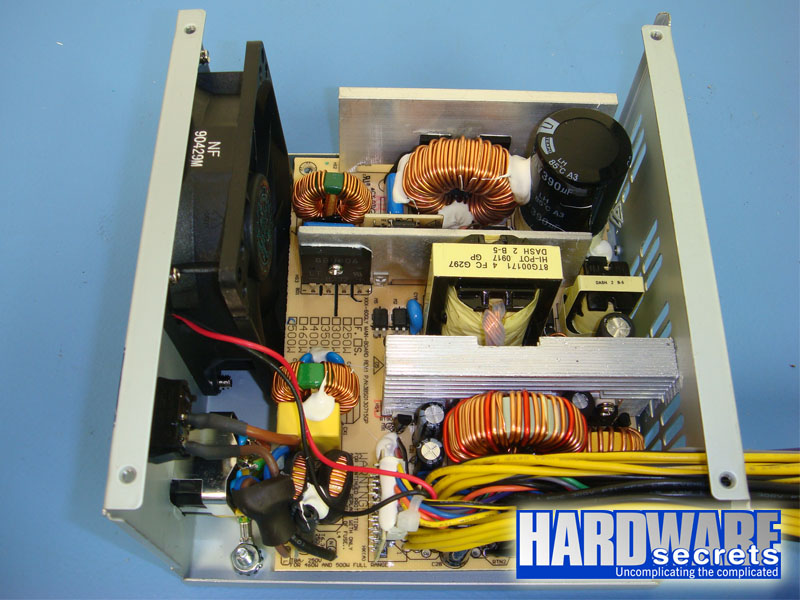 Figure 4: Overall look.
Figure 4: Overall look.
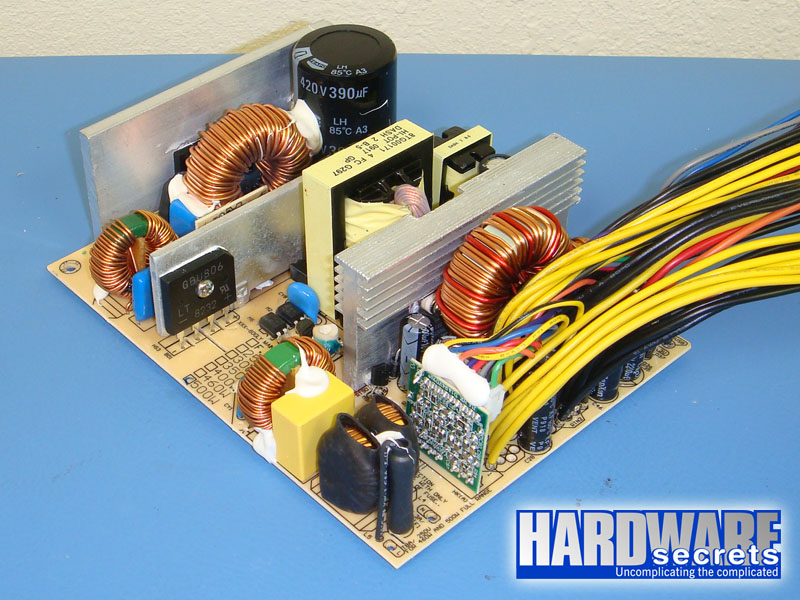 Figure 5: Overall look.
Figure 5: Overall look.
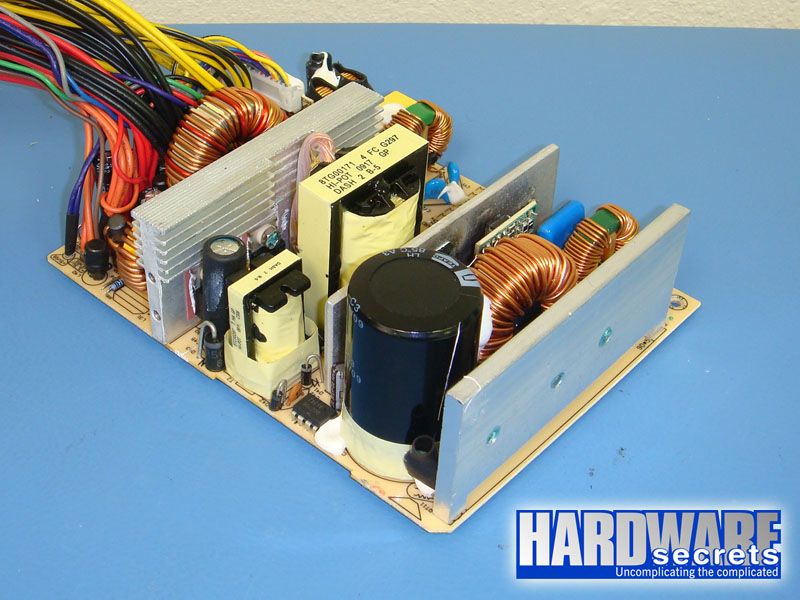 Figure 6: Overall look.
Figure 6: Overall look.
[nextpage title=”Transient Filtering Stage”]
As we have mentioned in other articles and reviews, the first place we look when opening a power supply for a hint about its quality, is its filtering stage. The recommended components for this stage are two ferrite coils, two ceramic capacitors (Y capacitors, usually blue), one metalized polyester capacitor (X capacitor), and one MOV (Metal-Oxide Varistor). Very low-end power supplies use fewer components, usually removing the MOV and the first coil.
This power supply has one X capacitor and two Y capacitors more than required, plus one extra X capacitor and one extra coil after the rectification bridge. However it does not feature a MOV, which is the component in charge of removing spikes coming from the power grid.
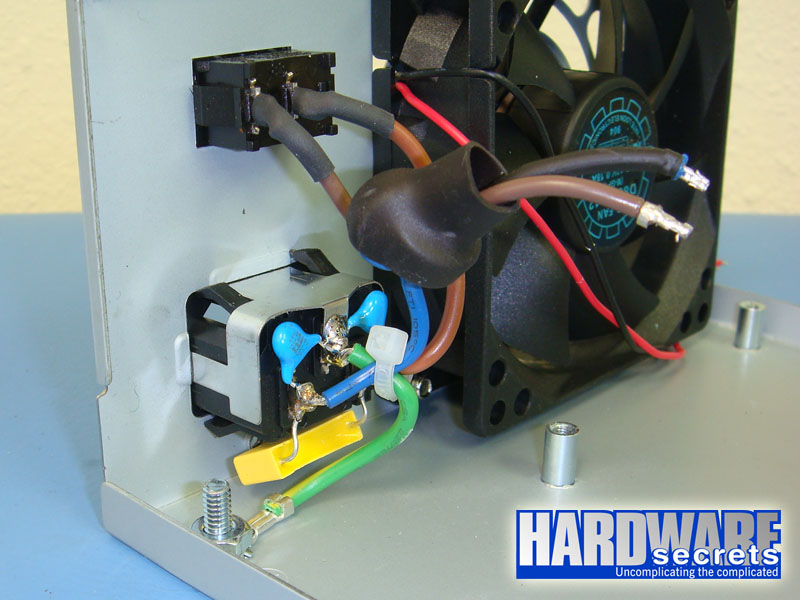 Figure 7: Transient filtering stage (part 1).
Figure 7: Transient filtering stage (part 1).
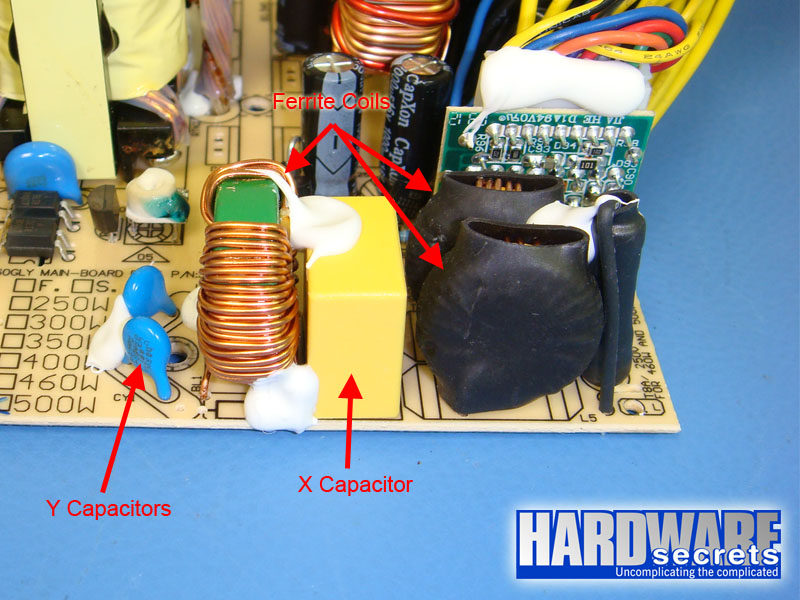 Figure 8: Transient filtering stage (part 2).
Figure 8: Transient filtering stage (part 2).
In the next page we will have a more detailed discussion about the components used in the Antec Basiq BP500U.
[nextpage title=”Primary Analysis”]
On this page we will take an in-depth look at the primary stage of Antec Basiq BP500U. For a better understanding, please read our Anatomy of Switching Power Supplies tutorial.
This power supply uses one GBU806 rectifying bridge in its primary, which can deliver up to 8 A at 100° C. At 115 V this unit would be able to pull up to 920 W from the power grid; assuming 80% efficiency, the bridge would allow this unit to deliver up to 736 W without burning this component. Of course we are only talking about this component and the real limit will depend on all other components from the power supply. This component is attached to a heatsink, meaning that it can really deliver what is published on its datasheet.
On the active PFC circuit two SPA20N60C3 power MOSFET transistors are used, each one capable of delivering up to 20.7 A at 25° C or 13.1 A at 100° C in continuous mode (note the difference temperature makes) or 62.1 A in pulse mode at 25° C, presenting a resistance of 190 mΩ when turned on,
a characteristic called RDS(on) – the lower this number the higher efficiency is.
 Figure 10: Active PFC transistors and diode.
Figure 10: Active PFC transistors and diode.
The electrolytic capacitor in charge of filtering the output from the active PFC circuit is Taiwanese from Teapo and labeled at 85° C.
In the switching section, another two SPA20N60C3 power MOSFET transistors are used on the traditional two-transistor forward configuration.
 Figure 11: Switching transistors.
Figure 11: Switching transistors.
The primary is controlled by a CM6800 PFC/PWM combo controller.
 Figure 12: PFC/PWM combo controller.
Figure 12: PFC/PWM combo controller.
Now let’s take a look at the secondary of this power supply.
[nextpage title=”Secondary Analysis”]
This power supply uses six Schottky rectifiers on its secondary.
The maximum theoretical current each line can deliver is given by the formula I / (1 – D), where D is the duty cycle used and I is the maximum current supported by the rectifying diode. Just as an exercise, we can assume a typical duty cycle of 30%.
The +12 V output is produced by two MBR3060CT Schottky rectifiers connected in parallel, each one having a maximum current limit of 30 A (15 A per diode at 95° C, 0.78 V maximum voltage drop). This gives us a maximum theoretical current of 43 A or 514 W for the +12 V output.
The +5 V output is produced by two MBRP3045N Schottky rectifiers connected in parallel, each one having a maximum current limit of 30 A (15 A per diode at 100° C, 0.80 V maximum voltage drop), giving us a maximum theoretical current of 43 A or 214 W for this line.
The +3.3 V output is produced by another two MBRP3045N Schottky rectifiers, giving us a maximum theoretical current of 43 A or 141 W for the +3.3 V output.
 Figure 13: +12 V, +5 V and +3.3 V rectifiers.
Figure 13: +12 V, +5 V and +3.3 V rectifiers.
This power supply uses a PS223 monitoring integrated circuit, which is in charge of the power supply protections, like OCP (over current protection). OCP was really activated, as we will talk about later. This IC also provides over voltage protection (OVP), under voltage protection (UVP) and over temperature protection (OTP, not implemented on this power supply), but not over power protection (OPP).
 Figure 14: Monitoring integrated circuit.
Figure 14: Monitoring integrated circuit.
Electrolytic capacitors from the secondary are from CapXon and labeled at 105° C.[nextpage title=”Power Distribution”]
In Figure 15, you can see the power supply label containing all the power specs.
 Figure 15: Power supply label.
Figure 15: Power supply label.
This power supply uses a dual-rail design distributed like this:
- +12V1 rail (solid yellow wire): All connectors but the ATX12V/EPS12V.
- +12V2 rail (yellow with black stripe wire): ATX12V/EPS12V connectors.
This is the typical distribution used on power supplies with two virtual rails.
Now let’s see if this power supply can really deliver 500 W.[nextpage title=”Load Tests”]
We conducted several tests with this power supply, as described in the article Hardware Secrets Power Supply Test Methodology.
First we tested this power supply with five different load patterns, trying to pull around 20%, 40%, 60%, 80%, and 100% of its labeled maximum capacity (actual percentage used listed under “% Max Load”), watching how the reviewed unit behaved under each load. In the table below we list the load patterns we used and the results for each load.
If you add all the power listed for each test, you may find a different value than what is posted under “Total” below. Since each output can vary slightly (e.g., the +5 V output working at +5.10 V), the actual total amount of power being delivered is slightly different than the calculated value. On the “Total” row we are using the real amount of power being delivered, as measured by our load tester.
+12V1 and +12V2 are the two independent +12V inputs from our load tester and during our tests the +12V1 input was connected to the +12V1 rail the +12V2 input was connected to the +12V2 rail, so on this test +12V1 and +12V2 really represents the rails by the same name on the power supply.
| Input | Test 1 | Test 2 | Test 3 | Test 4 | Test 5 |
| +12V1 | 4 A (48 W) | 7 A (84 W) | 11 A (132 W) | 14.5 A (174 W) | 18 A (216 W) |
| +12V2 | 3 A (36 W) | 7 A (84 W) | 10 A (120 W) | 14 A (168 W) | 18 A (216 W) |
| +5V | 1 A (5 W) | 2 A (10 W) | 4 A (20 W) | 5 A (25 W) | 6 A (30 W) |
| +3.3 V | 1 A (3.3 W) | 2 A (6.6 W) | 4 A (13.2 W) | 5 A (16.5 W) | 6 A (19.8 W) |
| +5VSB | 1 A (5 W) | 1 A (5 W) | 1.5 A (7.5 W) | 2 A (10 W) | 2.5 A (12.5 W) |
| -12 V | 0.5 A (6 W) | 0.5 A (6 W) | 0.5 A (6 W) | 0.5 A (6 W) | 0.5 A (6 W) |
| Total | 103.2 W | 194.8 W | 296.3 W | 393.9 W | 489.9 W |
| % Max Load | 20.6% | 39.0% | 59.3% | 78.8% | 98.0% |
| Room Temp. | 46.2° C | 45.6° C | 47.1° C | 46.6° C | 48.3° C |
| PSU Temp. | 47.2° C | 46.7° C | 46.8° C | 47.1° C | 47.8° C |
| Voltage Stability | Pass | Pass | Pass | Pass | Pass |
| Ripple and Noise | Pass | Pass | Pass | Pass | Pass |
| AC Po wer |
127.4 W | 234.7 W | 359.9 W | 486.9 W | 621.0 W |
| Efficiency | 81.0% | 83.0% | 82.3% | 80.9% | 78.9% |
| AC Voltage | 112.7 V | 111.6 V | 109.4 V | 108.9 V | 107.6 V |
| Power Factor | 0.976 | 0.988 | 0.994 | 0.996 | 0.997 |
| Final Result | Pass | Pass | Pass | Pass | Pass |
Antec Basiq BP500U proved to be a decent entry-level power supply. Efficiency was between 81% and 83% when we pulled between 20% and 80% from its labeled capacity (between 100 W and 400 W), dropping a little bit below 80% at 500 W, which is normal to happen with products from this class. It could really deliver its labeled power at 48° C and it didn’t burn or explode.
Voltage stability was one of the highlights from Basiq BP500U. The main positive voltages (+3,3 V, +5 V and +12 V) were always within 3% from their nominal values, i.e., they were closer to their nominal values than required by ATX specification, which allows a tolerance of up to 5% for them.
Ripple and noise levels were always below the maximum allowed (120 mV for +12 V and -12 V outputs and 50 mV for +5 V and +3.3 V outputs). Below you can see the results for test number five.
 Figure 16: +12V1 rail with the power supply delivering 489.9 W (51.8 mV).
Figure 16: +12V1 rail with the power supply delivering 489.9 W (51.8 mV).
 Figure 17: +12V2 rail with the power supply delivering 489.9 W (52.0 mV).
Figure 17: +12V2 rail with the power supply delivering 489.9 W (52.0 mV).
 Figure 18: +5 V rail with the power supply delivering 489.9 W (16.8 mV).
Figure 18: +5 V rail with the power supply delivering 489.9 W (16.8 mV).
 Figure 19: +3.3 V rail with the power supply delivering 489.9 W (35.8 mV).
Figure 19: +3.3 V rail with the power supply delivering 489.9 W (35.8 mV).
Now let’s see if we could pull more than 500 W from this unit.
[nextpage title=”Overload Tests”]
Before overloading power supplies we always test first if the over current protection (OCP) circuit is active and at what level it is configured.
In order to do that we increased current on the +12V2 rail until the power supply shut down. This happened when we tried to pull more than 20 A from it.
Manufacturers always leave a margin between what is written on the label (18 A in this case) and the level the OCP circuit is really configured (20 A in this case). We always like to see this margin as tight as possible, like happened with this power supply.
Then starting from test five we increased currents to the maximum we could with the power supply still running inside ATX specs. The results are below. If we tried to increase one amp on any of the outputs a protection would enter in action, shutting down the power supply. Nice.
| Input | Maximum |
| +12V1 | 20 A (240 W) |
| +12V2 | 20 A (240 W) |
| +5V | 18 A (90 W) |
| +3.3 V | 18 A (59.4 W) |
| +5VSB | 2.5 A (12.5 W) |
| -12 V | 0.5 A (6 W) |
| Total | 639.8 W |
| % Max Load | 128.0% |
| Room Temp. | 45.9° C |
| PSU Temp. | 45.1° C |
| AC Power | 854.0 W |
| Efficiency | 74.9% |
| AC voltage | 104.1 V |
| Power Factor | 0.998 |
[nextpage title=”Main Specifications”]
Antec Basiq BP500U power supply specs include:
- ATX12V 2.01
- Nominal labeled power: 500 W.
- Measured maximum power: 639.8 W at 45.9° C.
- Labeled efficiency: Information not available.
- Measured efficiency: Between 78.9% and 83.0% at 115 V (nominal, see complete results for actual voltage).
- Active PFC: Yes.
- Modular Cabling System: No.
- Motherboard Power Connectors: One 20/24-pin connector and two ATX12V connectors that together form one EPS12V connector.
- Video Card Power Connectors: Two six-pin connectors in one cable.
- SATA Power Connectors: Four in two cables.
- Peripheral Power Connectors: Five in two cables.
- Floppy Disk Drive Power Connectors: One.
- Protections: Information not available. Over current (OCP) and short-circuit (SCP) protections present and working.
- Warranty: Three years.
- More Information: https://www.antec.com
- Average price in the US*: 60.00.
* Researched at Newegg.com on the day we published this review.[nextpage title=”Conclusions”]
Antec Basiq BP500U is a pretty decent mainstream 500 W power supply that can really deliver its labeled power at 48° C – in fact we could pull up to 640 W from it.
Efficiency was between 81% and 83% when we pulled between 100 W and 400 W from it. At 500 W efficiency dropped a little bit below 80%, as it is normal to happen with products from this class.
Voltage stability was one of the highlights from Basiq BP500W, with the main positive voltages within 3% of their nominal values – i.e., closer to their nominal values than required by the ATX specification.
Ripple and noise levels were low at all times.
In summary, if you are building a basic or intermediate PC and want a power supply that will do the job and, at the same time, provides decent efficiency, great voltage stability, low ripple and noise levels and protections that work, you can save money by buying Antec Basiq BP500U.



Leave a Reply